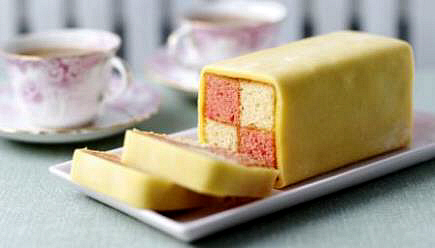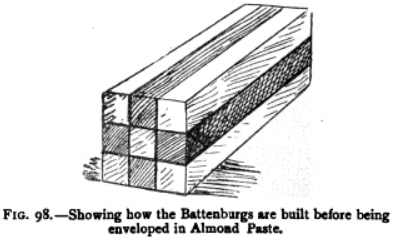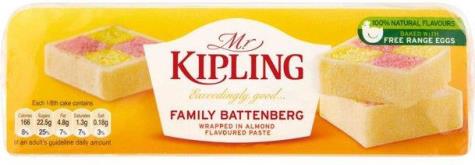

|
 (Or Battenburgh Cake) Now an oblong light cake made up from, usually four or very occasionally nine, small slabs of cake of square cross-section in two colours (usually pink and yellow) adhered together with jam so as to present square slices showing alternating blocks of colour. The whole covered with almond paste.  Image: http://ichef.bbci.co.uk/ The name is known at least since the end of the 19th Century, but first as a coated fruit sponge cake:  Original Receipt from 'Cassell's Dictionary of Cookery' (Cassell 1883) Original Receipt from 'Cassell's Dictionary of Cookery' (Cassell 1883)BATTENBERG CAKE. Crush four ounces of almonds with one egg and two table-spoonfuls of rum; then put twelve ounces of sugar with twelve yolks of eggs into a pan. Beat this until it is frothy, then add the crushed almonds, two ounces of currants, blanched and cleaned, and two ounces of mixed peel that has been passed through hot water. Add slowly eight ounces of flour rubbed through a sieve. Mix slowly, putting in the ten whites of eggs whipped firm. Finish with six ounces of good melted butter. Cook in a plum-cake mould, buttered. Turn it out of mould to cool. Soak it in kummel, brush over with apricot jelly, and ice with fondant or syrup of kummel. Sprinkle the sides and top with chopped pistachios. Probable cost, 3s. 6d. Battenberg Cake may take its name from the town of Battenberg in central Germany, the seat of the aristocratic family known in Britain as Mountbatten, whose Prince Louis married Princess Victoria, a granddaughter of Queen Victoria in 1884. The first modern version we find in Vine's Shop Goods...  Original Receipt from 'Saleable Shop Goods for Counter-Tray and Window:' by Frederick T Vine (Vine 1907) Original Receipt from 'Saleable Shop Goods for Counter-Tray and Window:' by Frederick T Vine (Vine 1907)No. 198.- Battenburg Cake. Take the Genoese cake batter (Nos. 191 or 192), divide it in two; colour one half pink with carmine, and leave the other plain; spread separately over a sheet ofpaper and bake to about one inch thick. When done, take oflf the paper, and cut up into square strips; then lay them alternately chess-board fashion, sandwiching them together with any kind of preserve - for the bottom layer, say two white and one red in the centre; for the second, two red and a white in the centre; and on top of that the same as the bottom layer.  When you have fixed them all together so (Fig. 98), make up the Almond Paste (No. 11), roll it out in a sheet, and after spreading some preserve upon the built-up square of cake, roll it round outside of the cake. Pinch along the edges and decorate with the point of a knife or skewer, by scratching a design upon it. The almond paste must not be too thick, or it will not look nice. Then either cut the cake up into inch sections, or sell whole at 1s. per lb.  2016  |
|
MORE FROM Foods of England... Cookbooks ● Diary ● Index ● Magic Menu ● Random ● Really English? ● Timeline ● Donate ● English Service ● Food Map of England ● Lost Foods ● Accompaniments ● Biscuits ● Breads ● Cakes and Scones ● Cheeses ● Classic Meals ● Curry Dishes ● Dairy ● Drinks ● Egg Dishes ● Fish ● Fruit ● Fruits & Vegetables ● Game & Offal ● Meat & Meat Dishes ● Pastries and Pies ● Pot Meals ● Poultry ● Preserves & Jams ● Puddings & Sweets ● Sauces and Spicery ● Sausages ● Scones ● Soups ● Sweets and Toffee ● About ... ● Bookshop ● Email: editor@foodsofengland.co.uk COPYRIGHT and ALL RIGHTS RESERVED: © Glyn Hughes 2022 BUILT WITH WHIMBERRY |